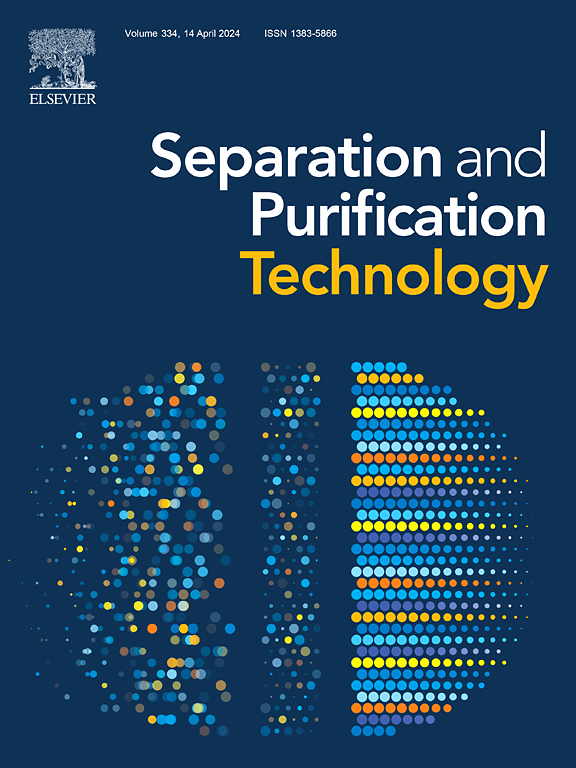聚苯并咪唑改性硅基吸附剂对高放废液中Pd的高效分离
IF 8.1
1区 工程技术
Q1 ENGINEERING, CHEMICAL
引用次数: 0
摘要
从高放废液(HLLW)中高效分离和回收钯(Pd)对于促进资源可持续性和推进核燃料循环至关重要。在这项研究中,通过聚合-真空浸渍-高温优化策略合成了一种富含氮吸附位点的新型硅基吸附剂(HT-paPBI@SiO2),以解决在高酸性和离子复杂环境中回收Pd(II)的挑战。利用SEM、EDS、TG - DSC、BET和FT - IR分析对HT - paPBI@SiO2进行了系统表征,证实了其结构刚性、孔隙度高、加载效率高、热稳定性好。静态间歇吸附实验表明,HT - paPBI@SiO2在较宽的酸度范围(0.1-9 M HNO3)内有效吸附Pd(II)。在6 M HNO3的模拟高浓水中,材料表现出优异的选择性(SFPd/其他金属离子>;1.05 × 103),饱和吸附量为128.2±1.8 mg/g。吸附动力学符合拟二级模型,而平衡数据符合Langmuir等温线和van 't Hoff热力学模型,表明这是一个自发的吸热单层化学吸附过程。此外,动态吸附实验成功地实现了从模拟高废液中选择性回收Pd(II),突出了HT-paPBI@SiO2在工业规模应用中的潜力。FT-IR, XPS和DFT计算支持的机理研究表明,paPBI中的苯环在高温处理下被氧化成醌结构。醌中的C=O基团与咪唑中的C=N−C基团相互作用产生的富电子区增强了对Pd(II)的亲和力。这种相互作用促进了氮和氧原子与Pd(II)的配位,而NO3−离子的配位则平衡了电荷。本文章由计算机程序翻译,如有差异,请以英文原文为准。

High-efficiency separation of Pd from high-level liquid waste by a novel silica-based sorbent modified with polybenzimidazole
The efficient separation and recovery of palladium (Pd) from high-level liquid waste (HLLW) are critical for promoting resource sustainability and advancing the nuclear fuel cycle. In this study, a novel silica-based sorbent (HT-paPBI@SiO2) enriched with nitrogen adsorption sites was synthesized via a polymerization–vacuum impregnation–high-temperature optimization strategy to address the challenges of Pd(II) recovery in highly acidic and ionically complex environments. HT‑paPBI@SiO2 was systematically characterized using SEM, EDS, TG‑DSC, BET, and FT‑IR analyses, which confirmed its rigid framework, abundant porosity, high loading efficiency, and excellent thermal stability. Static batch adsorption experiments demonstrated that HT‑paPBI@SiO2 efficiently adsorbs Pd(II) over a broad acidity range (0.1–9 M HNO3). In simulated HLLW at 6 M HNO3, the material exhibited outstanding selectivity (SFPd/other metal ions > 1.05 × 103) and a high saturation adsorption capacity of 128.2 ± 1.8 mg/g. Furthermore, the adsorption kinetics fit well with a pseudo‑second‑order model, while the equilibrium data conform to the Langmuir isotherm and van’t Hoff thermodynamic models, indicating a spontaneous, endothermic, monolayer chemical adsorption process. Furthermore, dynamic adsorption experiments successfully achieved the selective recovery of Pd(II) from simulated HLLW, highlighting the potential of HT-paPBI@SiO2 for industrial-scale applications. Mechanistic investigations, supported by FT-IR, XPS, and DFT calculations, revealed that the benzene ring in paPBI was oxidized to a quinone structure under high-temperature treatment. The electron-rich regions resulting from the interaction of the C=O group in quinone with the C=N − C moiety in imidazole enhance the affinity for Pd(II). This interaction facilitates the coordination of nitrogen and oxygen atoms with Pd(II), while NO3− ions coordinate to balance the charge.
求助全文
通过发布文献求助,成功后即可免费获取论文全文。
去求助
来源期刊

Separation and Purification Technology
工程技术-工程:化工
CiteScore
14.00
自引率
12.80%
发文量
2347
审稿时长
43 days
期刊介绍:
Separation and Purification Technology is a premier journal committed to sharing innovative methods for separation and purification in chemical and environmental engineering, encompassing both homogeneous solutions and heterogeneous mixtures. Our scope includes the separation and/or purification of liquids, vapors, and gases, as well as carbon capture and separation techniques. However, it's important to note that methods solely intended for analytical purposes are not within the scope of the journal. Additionally, disciplines such as soil science, polymer science, and metallurgy fall outside the purview of Separation and Purification Technology. Join us in advancing the field of separation and purification methods for sustainable solutions in chemical and environmental engineering.
 求助内容:
求助内容: 应助结果提醒方式:
应助结果提醒方式:


